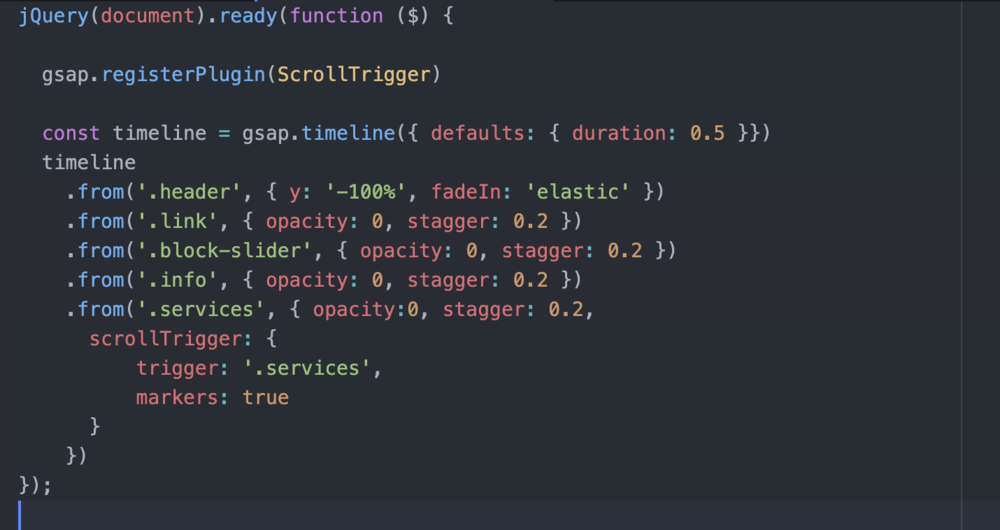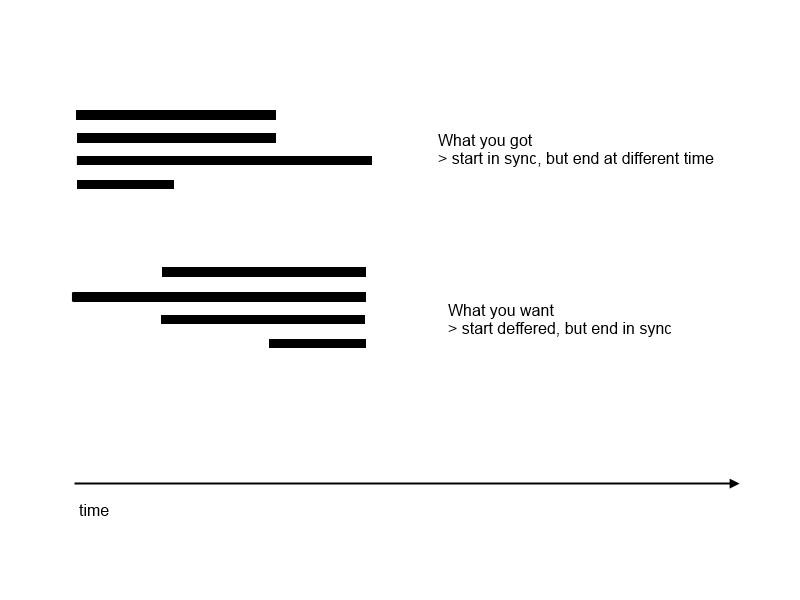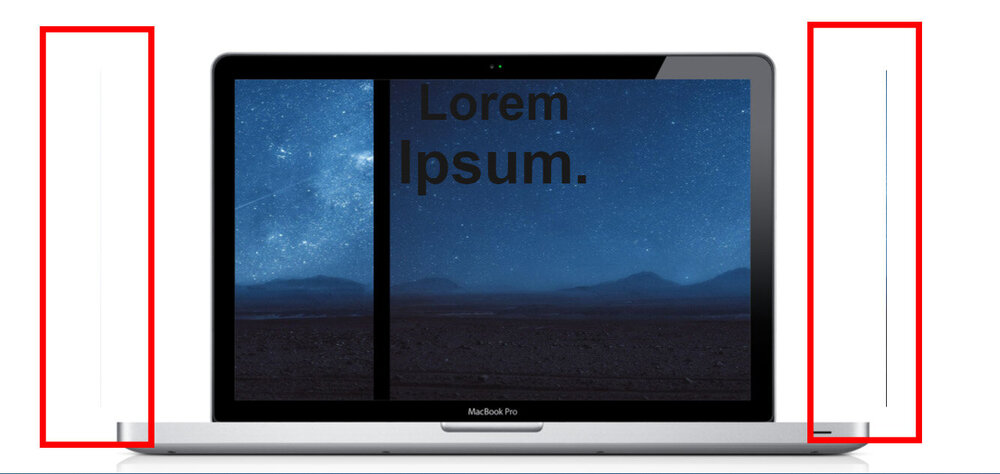Search the Community
Showing results for tags 'timeline'.
-
Hi Community, iam new in GreenSock GSAP and my question is maybe fixed in few seconds. I have a timeline, so that every animations starts with the end of the previous, this all works perfectly. Now i want to give the class .services a scrolltrigger so that the animation start when the element is in the viewport - i implemented in the timeline, but i dont know if this is correct or how i can do this. All approaches are welcome - if you can tell me whats the best solution for that, it would be great. Thanks in forward Martin
-
I have a Timeline working fine on a hierarchical tree (DOM document) in which selected classes of SVG elements are animated. However, the tree is collapsible, and when a node is collapsed, the element that is animated in that node is removed from the DOM. That's Ok, no problem. But when that node is expanded again via a mouse click on its parent, the element gets added again to the DOM, but the Timeline does not, of course, act upon the newly-created element to animate it. Is there a way to make the Timeline aware of elements that are dynamically created and whose class does fit the Timeline target parameter? I am hoping that I won't need to actually create a new Timeline to animate these dynamically created elements - for then I would have multiple Timelines targeting the same class of elements, and that seems problematic to me. I have tried a number of things to solve the issue, but to no avail. I either get what appears to be multiple instances of the Timeline colliding with each other, or else new elements animating as desired while existing elements (that have not been disturbed) not animating at all after some other node has been dynamically created.
-
Hey guys, I have an issue an I'm looking for help. I have a page that has a parallax effect in all of the sections of a page whenever the user scrolls. So there are this black text blocks that are separated but whenever you scroll one of the blocks moves up to be next to the one on top, the issue is that this is causing a blank space between sections of the page. I want to know if there is a way, whenever the black text block moves up, to make the sections below move up as well, basically follow that text block whenever it goes up. I try this by just using a yPercent on the sections below, but is is just causing a blank space to be left on the bottom of the page Here is a link of how the animation should work https://drive.google.com/file/d/1EsKinyuID5buWKhQllRhE1Bmc6el5GTX/view and I left a codepen with the basic markup of my current pate. Any help would be appreciated.
- 3 replies
-
- scroll
- scrolltriger
- (and 4 more)
-
I don't have a codepen but basically what i want to achieve is this: I have some data loading in the background, and i'm using GSAP3 to create a timeline that's animating an svg infinitly, it's a preload animation basically. What i want to do is that when the data is loaded, i want to pause the current timeline object, animate it until the progress is 1, and then when the animation is completely finished i want to create another animation to smoothly animate the preloader out of the screen and then show the loaded data. I saw an example of this in GSAP2 using TweenMax where: you pass the tweenmax object into the to() method, animate the progress property and then assign a callback function to the onComplete() property to kill the timeline object, but that doesn't seem to work in GSAP3, the svg abruptly jumps to the it's final state (where the progress is equel to 1) instead of animating to it. Can you please tell me how can i achieve this? I can't seem to find any example of this in GSAP3. Thanks in advance!
-
Hi Guys, Thanks for this awesome gsap lib again. I'm still learning it but the library is really powerful and quite fun to explore. I need some help with the animation where my container gets pinned on screen and then the image is horizontally moved with the scrolling. This part works fine in the codepen above. What I need with this is for the text in the adjacent container to smoothly show hide along with this image movement. Obviously the number of texts will be the same as the image movements so that wont be a problem. Thanks for any help in advance.
- 3 replies
-
- show hide
- scrolltriger
- (and 5 more)
-
this.menuTimeLine = gsap.timeline({ paused: true, }); this.menuTimeLine .fromTo(this.ref.menu, { x: "-100%", }, { x: "0%", duration: this.state.open ? 0.3 : 2, ease: this.state.open ? "linear" : "expo.out", }, 0).reverse() if (this.menuTimeLine.reversed()) { this.menuTimeLine.play() } else { this.menuTimeLine.reverse() } Button.addEventListener('click', () => { if (this.menuTimeLine.reversed()) { this.menuTimeLine.play(); } else { this.menuTimeLine.reverse() } }) Update Prop or Tween value conditionally whatever it is normal gsap or gsap timeline In Gsap version 2.x.x updateTo can update tweening values or gsap props but what to do in gsap 3.x.x or Gsap vars can help in this issue ? in Codepen example dynamic ease or duration ? besause timeline is outside of onClick ?
-
Hi everyone, I have to create pages that have 4 animations each that can be activated at the click of 4 focus points that I inserted in an svg image, the animation hides the initial text and makes the text of each focus point appear, for the first I managed the problem occurs when I have to animate the others, who have to hide both the initial text and the contents of the other focuses already seen by the user. In practice, if I click 1 it hides 2,3,4 and the initial text, if I click 2, it hides 1,3,4 and so on. I gathered to also set the reverse function so that if I double click on a focus point the initial text reappears, but when I go to add the others everything overlaps. Do you have any suggestions, I mainly used #IDs maybe I need to organize better in classes ??
-
The dots here is the title
-
Hi Guys, I am trying to create a seamless "clipMask Text Marquee", with a timeline. The tl is started (and paused) by ScrollTrigger. Basically everything works as desired, but I have trouble with resizing. The height of the text (trigger Element) is changed by a js function. After Resizing the hight, the position of the triggers become wrong. Is there a way to update them? Or is there generell a better apporach? I am not a big expert (as you guessed) and very thankful, for honest “code critique”. Furthermore I wonder, if and how I have to kill the timeline in PJAX-context. By now it works, when I kill the ScrollTrigger (before entering) the Page and call the createMarquee (after entering) again. Is this enough or is the (old and unused) Timeline (created by function) still present somewhere in memory? Sorry for my English and many thanks in advance.
- 2 replies
-
- scrolltriger
- timeline
-
(and 1 more)
Tagged with:
-
I am working on a game that has timer that is animating down, it indicates how much time player has left to make their move. Gsap is animating this timer. Issue I am currently facing is that if player goes to a different browser tab gsap seems to stop animating the timer. After some research I believe this is by design and feature responsible for this is "lagSmoothing" I was able to disable this via "gsap.ticker.lagSmoothing(0)". However this disables lag smoothing for my whole app. I was trying to look similar method on "TimelineLite" that I am using for timer animation, but wasn't able to find anything. Hence this question: Can I disable lagSmoothing for single timeline as opposed whole app? Here is an example of how timeline lite is used in my app. import { TimelineLite } from 'gsap' const timeline = new TimelineLite() this.timeline.to(this, { /* animation config*/ })
-
As you see in codepen link the animation work but not well, when you make a scroll the red element move as normal, also the blue element works normally, but if you continue scrolling, you will arrive at to step, you can't look at the animation. I want to move it as a position fixed moving my scroll.
- 1 reply
-
- scrolltrigger
- gsap
-
(and 1 more)
Tagged with:
-
Hi, I am quite new to gsap. One problem I have, is that when I reverse the timeline, or just make an animation, that scales something down. It leaves the outline on the element, multible times along the path in took. This makes the animation cumpletly useless, since it looks like crap. Im sure this is a bug, and can be fixed, but how? I've linked the file below. Thanks in advance :) test.html
-
I'm attempting to create a fade-in parallax effect on the text as you scroll the page. So far the effect is working quite well — barring a slight hiccup that occurs every time the page is visited for the first time (and when refreshed). The element (which should have an starting opacity of 0) is clearly visible if you scroll down from the hero section into the intro section. Once it passes the scroller-start point only then it goes it 0 — causing a flash and jerk of content. Oddly, now if you were to scroll back up and down the page — it works as intended. At my wits end here. I thought fromTo properly handles the animation values before/after animating (it does seem to but not right off the bat) and immediateRender is automatically true if you use ScrollTrigger/fromTo. Not sure what else I am missing. How can I get it so it starts off after page load at 0 opacity and -20% y?
- 1 reply
-
- scrolltrigger
- timeline
-
(and 2 more)
Tagged with:
-
?? hello fellow humans. feels really nice to join this awesome community. i found so much help here already. now its time to make my own first post. - - - so! i would love to get some help on positioning tweens inside a timeline as i was not able to find an elegant solution until this point. the attached image explains what i got and what i want. so i have a main tween in my timeline that has a duration of 2s. and a few others that are shorter in time. now, basically i want to dynamically align all the other tween endpoints with the main tween's endpoint. i say dynamically because tween durations will change within the website. i know that i can use the relative position parameter for this. and with absolute numbers it works beautifully: // create timeline let timeline = gsap.timeline(); // add tweens timeline.add(container.fadeOut(), 0); timeline.add(elements.fadeOut(), '-=1.2'); timeline.add(footer.fadeOut(), '-=1.4'); timeline.add(progress.reset(), '-=1.8'); but what happens if for example my footer.fadeOut() tween changes its duration to 0.8s? with my code example, the endpoints of footer.fadeOut() and container.fadeOut() are not aligned anymore. how can i dynamically change the -1.2s to -0.8s? how can i subtract the tweens own duration, relative from the timeline endpoint? and how can i do this elegantly without using tons of variables to get each tween's duration? thank you so much for taking your time. stay healthy, stay safe. jaro ??
-
I dont have a codepen to show or reproduce what my large scale app does but I am using fabric.js to create animations on canvas and have multiple slides to convert it to a slideshow or video. All i can share is a small snippet of where i call the functions at certain time i.e particular card.duration (which can take decimals as well). But the next function is called before the designated absolute duration. All I want to know if timeline accepts millisecs and makes gauranteed call at that particular time! totalDuration = 0; for (let i = 0; i < cardLinkedList.length; i++) { const card = cardLinkedList[i]; timeline.call( textAnimation, [canvas, card, transition, logo], totalDuration ); totalDuration += card.duration; } timeline.play();
-
hi, I have a problem on ios devices with scrollTrigger, when I scroll, scroll suddenly skips or jumps, I have no idea why this happens because the code I wrote is only this. There's a video at the bottom that you can see what I mean. Thank you for your attention:) gsap.timeline({ scrollTrigger:{ trigger:'#s0', scrub:true, start:'top top', end: 'bottom -220%', pin: '#s0', } }) // .to('#photo1',{maskImage: 'linear-gradient(rgba(0, 0, 0, 1) 0%,rgba(0, 0, 0, 1) 0%,rgba(0, 0, 0, 0) 50%)'}) .to('#photo1', { opacity: 0 }); idk.mov
-
Hi folks! I need help to implement a new timeline from tweens that are building into a loop. (btw, I use as a base this pen https://codepen.io/osublake/pen/ExPMgQq, credits to Blake Bowen) If is use a gsap.exportRoot() into a const, I have control over the timeline (but there isn't apply to use into a component) . So but I use tl.add(tween) into the loop I can't reach the same result . Also I tried with tl.add(tween, 0) but isn't work for me. Surely I'm doing something wrong, but I can't discover what, so if you can help me I will be appreciated. Thanks. ?
- 4 replies
-
- exportroot
- svg
-
(and 1 more)
Tagged with:
-
Hi all. This is my first post on the forum! I was hoping for some advice with a scroll based interaction I am working on. Essentially I have a fullscreen panel, containing a video and an H1 positioned on top (in reality I think the H1 will be an SVG logo). I am looking to have the H1's position on the Yaxis adjusted as you scroll down the page, effectively going in the opposite direction to normal, and disappearing from view out the bottom of its parent container. I have built this out the best I can so far using a gsap timeline and scroll event on the window. It all works as it should, it doesn't really feel great and can be a little jerky to begin with... so my questions would be... Is my approach suitable for this ? Are there any quick wins I could make to improve it? Or should it be done another way eg. scrollTrigger ? (No idea how to do this atm) Any advice greatly appreciated. Many Thanks!
-
Hi everybody! I have a problem configuring a menu animations. That's my 5th version. I realised the best way is to use master timeline. But, trying to put it all together, I get an unpredictable behavior. Animation for showing/hiding dimmer works great. dimmer_tl .fromTo(dimmer, {opacity: 0, display: 'block'}, {opacity: 1}) .set(js_dimmer, {display: 'block'}) .add('show') .to(dimmer, {opacity: 0, display: 'none'}) .set(js_dimmer, {display: 'none'}) .add('hide') dimmer_tl.tweenTo('show'); dimmer_tl.tweenTo('hide'); But truing to do the same with menu background doesn't work :( bg_tl .fromTo(bg, {opacity: 0, display: 'block'}, {height: 200, opacity: 1}) .add('show_list') .fromTo(bg, {opacity: 0, display: 'block'}, {height: 100, opacity: 1}) .add('show_search') .to(bg, {opacity: 0, display: 'none'}) .add('hide') bg_tl.tweenTo('show_list'); bg_tl.tweenTo('hide'); It feels like the animation on show_list is not pausing and going threw all of them bg_tl .fromTo(bg, {opacity: 0, display: 'block'}, {height: 200, opacity: 1}) .add('show_list') // .fromTo(bg, {opacity: 0, display: 'block'}, {height: 100, opacity: 1}) // .add('show_search') // .to(bg, {opacity: 0, display: 'none'}) // .add('hide') Or maybe I'm trying to reinvent the wheel and there are better practices to control? I'm glad to hear any suggestions. Thanks! P.S. Also moving mouse really fast between links play a timeline through all of them. I guess I need to add a delay somewhere but every time I do so it's just breaking apart.
-
Hi, i am just getting to know gsap and i have a little problem :/. I am writting a page in gatsby and made a mobile side menu with gsap but i noticed that when the menu is opened for the first time and closed, after resizing the window, the menu doesn't change its position on the x-axis and starts sticking out. const Header = () => { const [isOpen, setIsOpen] = useState(false) const menuRef = useRef(null) const menuBtn = useRef(null) const tl = useRef() const toggleOpen = () => { setIsOpen(!isOpen) } useEffect(() => { const nav = menuRef.current const mainMenuLists = [...nav.querySelectorAll("ul:nth-of-type(1) li")] const socialLists = [...nav.querySelectorAll("ul:nth-of-type(2) li")] const btn = menuBtn.current const upLine = btn.querySelector("span:nth-of-type(1)") const centerLine = btn.querySelector("span:nth-of-type(2)") const downLine = btn.querySelector("span:nth-of-type(3)") tl.current = gsap .timeline() .to([upLine, downLine], { y: "-50%", duration: 0.3 }) .to(upLine, { duration: 0.1, rotation: 45 }, 0.2) .to(downLine, { duration: 0.1, rotation: -45 }, 0.2) .to(centerLine, { duration: 0.1, autoAlpha: 0 }, 0.2) .to(nav, { x: "0", duration: 0.5, autoAlpha: 1 }) .staggerFromTo( mainMenuLists, 1, { x: "-=15px", autoAlpha: 0 }, { x: "0", autoAlpha: 1 }, 0.2 ) .staggerFromTo( socialLists, 0.5, { y: "+=3px", autoAlpha: 0 }, { y: "0", autoAlpha: 1 }, 0.1 ) .reverse() }, []) useEffect(() => { tl.current.reversed(!isOpen) }, [isOpen]) return ( <HeaderComponent> <Logo> <AniLink path="/" hex="#333"> <LogoImg /> </AniLink> </Logo> <OpenMenuBtn ref={menuBtn} onClick={toggleOpen}> <span /> <span /> <span /> </OpenMenuBtn> <Nav menuRef={menuRef} setIsOpen={setIsOpen} /> </HeaderComponent> ) } const Nav = styled.nav` position: fixed; top: 0; left: 0; bottom: 0; right: 0; transform: translateX(100%); background-color: #ccc; z-index: 99; ` const Navigation = ({ setIsOpen, menuRef}) => { return ( <Nav ref={menuRef} onClick={() => setIsOpen(false)}> ... </Nav> ) } I think i know what the problem is. Timeline is created when the component is mounted and the first time the menu is opened it pops up getting translate (0). When I close the menu, the animation returns back and gsap assigns to the translate (x), value from the start of the animation. because the animation is set to reverse (I know it's obvious) . I wonder if there is any possibility to change the value of position x only when the animation returns?(Because I can't/ i don't know how do this animation differently: D) https://ibb.co/f8Y0Tg5 short demo
-
Fire complete animation at once within ScrollTrigger with scrub
nevanthegreat posted a topic in GSAP
Hello Club Green Sock! I was reading about the common Scroll Trigger mistakes looking for a solution to this question. I think may be going about this the wrong way, but... I have a timeline let hardwareTimeLine = gsap.timeline({ scrollTrigger: { trigger: ".centering-container", scrub: true, pin: true, pinSpacing: true, start: "top", end: "150%" } }); hardwareTimeLine .from(".hero-header", {}) .fromTo(".animated-header", {autoAlpha: 1, top: "29%"}, {autoAlpha: 0, top: "27%"}) .fromTo(".scaling-container", {duration: 1, scaleX: 1.6, scaleY: 1.6, transformOrigin: "50% 50% 0", backgroundPosition: "center"}, {duration: 1, scaleX: .6, scaleY: .6, transformOrigin: "50% 50% 0", backgroundPosition: "center"}, "<") .fromTo(".screen-inner-1", {duration: .5, transform: "translateX(0)"}, {duration: .5, transform: "translateX(-103%)"}) .fromTo(".screen-inner-2", {duration: .5, transform: "translateX(103%)"}, {duration: .5, transform: "translateX(0)"}, "<") .from(".icons-tray", {y: 150, autoAlpha: 0}); and I was wondering if there was a way to put a tween inside the timeline that is attached to the Scroll Trigger at the very end of my last ".from", if that makes sense? I tried .tweenTo() but that didn't seem to give the effect I am searching for. For example (see my codepen, you may need to look it at on full screen) I would like the grey box (".icons-tray") to tween up on it's own and only be started by the scroll trigger. Can anyone point me in the right direction of the way to approach this effect or have a working demo that shows this? Thank you so much!!! -
So I have a simple GSAP timeline to move an element with the direction of the mouse' event: node.addEventListener("mousemove", e => { const x = e.clientX / 10; const y = e.clientY / 10; gsap.timeline() .to(blurRef.current, { yPercent: -30, x, y, duration: 1 }, 0) }) It works fine, but I want to add an infinite bounce effect which happens simultaneous to the mouse animation. I've done the bounce effect only before with pure css, but this makes GSAP stop working (mouse effect won't work). Is there a way to handle both simultaneously? Is there an equivalent for the CSS with GSAP? .blur { animation: bounce 2s infinite ease-in-out; } @keyframes bounce { 0% { transform: translateY(-10px) } 50% { transform: translateY(15px) } 100% { transform: translateY(-10px) } }
-
Hi there, I am very new to javascript and trying to keep the code readable. I want my timeline to be in a separate function and being played and reversed on a button click. However, the animation only fires forward, but never backwards and I cant get my head around it. If I put the timeline into the constructor method it suddenly works, but not if putting it into a separate function. The codepen is a very simplified version for the main issue. I'd glad if someone could lend me a helping hand. If you have better suggestions how to structure the code, I am very open to learn something. Just want to write it as clean as possible.
-
Hey Club Greensock! I was just wondering if I could get some assistance on my project. I have a pretty good base (I think). I just had a couple questions and was wondering if someone might be able to give me some ideas and direction. In my pinned timeline, I have a container that I scale down. I am wondering how might one go about how to decrease the pin spacing as this timeline progresses? As you can see in the image, there is a huge gap due to the scale down. Is there a way to adjust the pinspacing so the final resting place of the animation obeys the global defaults I have setup for the section container? If that makes sense? Specifically if you look at my pen on chrome, there is a weird thing it's doing where there's like a slight margin that is revealing the background slide as it moves. It doesn't do this on FF. Tell me if there is a better way to do this, but basically I have the laptop as a png, the screen area is the transparency, and I have a white bg on the sides of the screen image (to hide the slides) and then I did an overflow: hidden on that laptop png. I know there's got to be a better, more flexible way of doing this. Any suggestions? I would like to setup a global tween (".reveal-up") that I can apply to be flexible to many elements on the page (sort of how like green sock does it here). I have it setup on the header and text in the section with the boxes that rotate and "fly-in". It plays, but it doesn't play when in view, rather it plays at the top of the page. How can I approach this to be more flexible so it plays when in view and also be able to apply it to other elements? Tweening inside my scroll trigger timeline. Specifically I am talking about the text "Lorem Ipsum" that is layerd above the laptop. I know how to make it part of the scroll, but is there a way to trigger it on scroll, but not to play with the scroll? If that makes sense. How would one go about triggering it on scroll, but to play through regardless of the users inputs on the scroll and additionally to reset? I am not sure if this is a thing, but when the browser resizes, there's some funkiness that happens to the timelines. Is there a way that I can make it more flexible on browser resize so the funkiness doesn't happen? Thank you for any help. Here's a couple images to assist in my questions:
- 8 replies
-
- pin spacing
- timeline
-
(and 1 more)
Tagged with:
-
Your animation workflow is about to get a major boost. GSDevTools gives you a visual UI for interacting with and debugging GSAP animations, complete with advanced playback controls, keyboard shortcuts, global synchronization and more. Jump to specific scenes, set in/out points, play in slow motion to reveal intricate details, and even switch to a "minimal" mode on small screens. GSDevTools makes building and reviewing GSAP animations simply delightful. Get Started Load the JavaScript file //be sure to use a path that works in your dev environment <script src="./js/GSDevTools.min.js"></script> Instantiate GSDevTools GSDevTools.create(); That's it! The demo below shows GSDevTools running with its default settings. It automatically gives you control over every animation on the global timeline. Select an animation by id Any GSAP animation (tween or timeline) can be assigned an id (a string) which causes it to show up in the animation menu. That makes it easy to jump to any scene. Notice how the timeline and each tween below have an id assigned: //give the timeline and child tweens their own id. var tl = gsap.timeline({id: "timeline"}) tl.to(".orange", {duration: 1, x: 700, id: "orange"}) .to(".green", {duration: 2, x: 700, ease: "bounce", id: "green"}); //give this tween an id gsap.to(".grey", {duration: 1, x: 700, rotation: 360, delay: 3, id: "grey"}) //instantiate GSDevTools with default settings GSDevTools.create(); Now each id shows up in the animations menu (lower left). Persistence between refreshes For added convenience, when you manually set the in/out points, animation, timeScale, or looping state in the UI, they persist between refreshes! This means you can drag the in/out points to isolate a particular section and then tweak the code, hit refresh, and see the changes immediately within that cropped area. Any values set in the GSDevTools.create({...}) method will override manual selections. Set persist: false to disable persistence. If you encounter persistence contamination (e.g. setting timeScale in one affects another), simply assign a unique id to the GSDevTools instance (the recorded values are segregated by id, session, and domain). Configuration options GSDevTools can be configured extensively. Optionally define any of these properties in the config object: animation [string | animation] - If you define an animation, like animation: myTimeline, animation: myTween or animation: "id", that animation will be initially selected. By default, the global timeline is selected. container [string | element] - Specify the container element for GSDevTools, like: "#devTools" or document.getElementById ("devTools"). css [object | string] - The CSS you want on the outer div, like {width:"50%", bottom:"30px"} or a string of css like "width: 50%; bottom: 30px". It is safe to use GSAP-specific shortcuts like x, yPercent, etc. in the object syntax because it just gets passed to a gsap.set() internally. globalSync [boolean] - By default, animations are kept in context and synchronized with the root timeline (scrubbing one scrubs them all), but you can set globalSync: false to unhook it from the global timeline. Note: only one GSDevTools instance can be globally synchronized on a page (otherwise scrubbing them both to different times would break the time-space continuum). hideGlobalTimeline [boolean] - If true, the Global Timeline will be removed from the animation menu. id [string] - A unique string to identify the GSDevTools instance. The persistent values between refreshes are mapped to this id, so if you ever run into a case where there's cross-contamination of the persistent values (like if you embed multiple codepens on one page and don't want timeScale changes in one to affect the others on refresh), just make sure you give each one a unique id. inTime [number | string] - Position of the in marker (time, in seconds, or label or animation id). You can even use relative values like "myAnimation-=2" to start 2 seconds before the animation with the id of "myAnimation". If you use just a negative relative value like "-=5" , it will be measured from the end of the timeline, making it easy to just watch the final 5 seconds. keyboard [boolean] - If true (the default), keyboard shortcuts will work. Note: only one GSDevTools instance can listen for keyboard shortcuts. paused [boolean] - Initial paused state. loop [boolean] - Initial loop state. minimal [boolean] - If true, the UI will only show minimal controls (scrubber, play/pause, and timeScale). Note: when the screen is less than 600px it automatically switches to minimal mode anyway. outTime [time | label] - Position of the out marker (time, in seconds, or label, or animation id). You can even use relative values like "myAnimation+=2" to end 2 seconds after the animation with the id of "myAnimation" ends. If you use just a positive relative value like "+=5", it will be measured from wherever the inTime is. persist [boolean] - By default, GSDevTools remembers the in/out points, selected animation, timeScale, and looping state between refreshes in the same domain session, but you can disable that behavior by setting persist: false. timeScale [number] - Initial timeScale. visibility [string] - "auto" causes the controls to automatically hide when you roll off of them for about 1 second, and return when you move your mouse over the area again. Default is "visible", or you can set it to "hidden" to hide the controls initially (useful if you don't want the controls to obscure any part of the screen - you can still use the keyboard shortcuts to control playback or tap the "H" key to toggle visibility). Keyboard Controls SPACEBAR: Play/pause UP/DOWN ARROWS: Increase/decrease timeScale LEFT ARROW: Rewind RIGHT ARROW: Jump to end L: Toggle loop I: Set the in point to current position of playhead O: Set the out point to current position of playhead H: Hide/show toggle Tips and tricks Clicking the GreenSock logo (bottom right) gets you right to the GreenSock docs! Double-click on the in/out marker(s) to reset them both immediately. If the playback UI is obscuring part of your animation, just tap the "H" key to hide it (and again to bring it back) - you can still use all the keyboard shortcuts even when it's invisible. Advanced demos We purposefully chose very basic animations for the demos above, but here are a few that illustrate how easy GSDevTools makes it to control and debug even super-complex animation sequences. How do I get it? GSDevTools is available to Club GreenSock members ("Shockingly Green" and above). Just download GSAP with the bonus files zip from your Dashboard. Try GSDevTools for free on CodePen. To learn how to include GSDevTools into your project, see the GSAP install docs. FAQ Why is my global timeline 1000 seconds long? That means you've probably got an infinitely repeating animation somewhere. GSDevTools caps its duration at 1000 seconds. Scrubbing to Infinity is awkward. Does loading GSDevTools impact runtime performance? Since it must monitor and record the root timeline, yes, there is a slight performance hit but probably not noticeable. Keep in mind that usually you'll only load GSDevTools while you're developing/reviewing your animations and then remove it when you're ready to launch, so ultimately it shouldn't be much of a factor anyway. Why isn't GSDevTools in the CDN or GitHub repo? Because it's a membership benefit of Club GreenSock. It's a way for us to give back to those who support our ongoing development efforts. That's why we've been able to continue innovating for over a decade. See https://greensock.com/why-license for details about our philosophy. Does GSDevTools work with other animation libraries? Nope, it depends on some unique capabilities baked into the GSAP architecture. What will I do with all the time this tool saves me? Take up a new hobby, ponder deep philosophical questions, make cookies - it's up to you.
-
- 5
-

-
- javascript
- animation
-
(and 8 more)
Tagged with:







